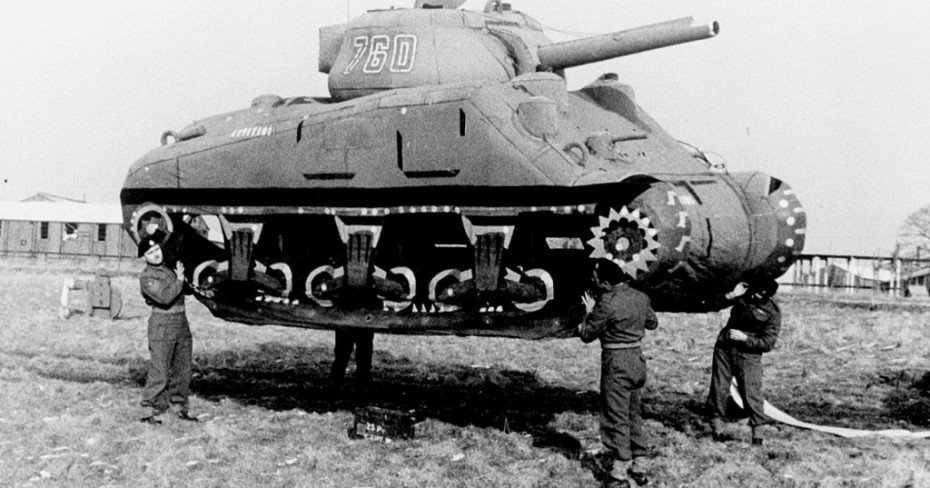American’s Ghost Army
- Nathan Schneider

Just a few days, a man named Gilbert Seltzer died. He was 106 years old, which in and of itself is a remarkable age to live to see. But as it turns out, up until a couple days ago, he was one of only a small and dwindling number of men still alive who were part of a very elite, very secretive unit in the US military during World War 2. The unit was formally known as the 23rd Headquarters Special Troops. But it is probably more well known by its more popular title: the Ghost Army.
The Ghost Army was a unit comprised of 1,100 men whose mission during the war was to employ tactical deception in order to thwart enemy activity, attacks, defenses, and counter-assaults. What kind of deception? Well, everything from the use of inflatable decoy tanks, sound trucks used to simulate the movement of men and vehicles, fake radio transmissions, etc. They constructed dummy airfields, troop bivouacs, motor pools, artillery batteries, and tank formations for enemy arial surveillance. They played recordings of armored and infantry units from powerful amplifiers and speakers mounted on trucks in order to simulate troop and armor movement in false locations, which could be heard up to 15 miles away.
The unit’s operations was integral in providing deception maneuvers in preparation for the D-Day invasion, which proved to be overwhelmingly successful in fooling the German army as to the true location of the invasion. Following the Allied invasion, the unit operated in France and elsewhere in Europe and had just as much success deceiving allied forces in France as they did deceiving German intelligence.
In March 1945, in perhaps one of their most effective and complex employments of tactical deception, the unit set up 10 miles south of the spot where two American Ninth Army divisions were to cross the Rhine River in a final campaign to crush the German army. The Ghost army’s objective was to simulate a backup of those divisions in decoy locations so as to draw German attention away from the assaulting force. They used inflated tanks, cannons, planes, trucks. They sent out fake radio messages about American troop movements. And they used loudspeakers to simulate the sound of soldiers constructing pontoon boats to cross the river. A NY Times obituary for Seltzer wrote, “The Germans fell for the ruse, firing on the 23rd’s divisions, while Ninth Army Troops crossed the Rhine with nominal resistance.” Seltzer himself, commenting on this particular action, noted, “We were able to get the German army to assemble opposite us, firing at us. And when the actual crossing was made, about 20 miles to our north, there was practically no resistance.”
The Ghost Army, which turned out to be one of the most effective units in the American military, according to Smithsonian magazine is believed to have saved the lives of upwards to 30,000 American lives. The mission of the Ghost Army, which had been classified top secret for 50 years, was officially declassified in 1996. Seltzer’s comment on being a part of this extraordinary unit is encouraging: “It was funny, it was distasteful, it was crazy. We did it to overcome a terrible, terrible enemy. And the fact that we did so successfully is probably the biggest source of pride.”
I had never heard of the Ghost Army before running across the headline about Gilbert Seltzer, but I was fascinated and not a little amused by the various means by which war is waged and won. I’m sure a guy like Seltzer and his fellow soldiers felt silly at times fighting the Nazi war machine with inflatable tanks and loudspeaker halftracks. But it worked. And that’s a good lesson for us to remember as we feel silly at times fighting a spiritual war using weapons and tactics that are, in the words of the apostle Paul, “not of the flesh” (2 Cor. 10:4). But they work, and they have “divine power to destroy strongholds.” I don’t know about you, but I’d rather have weapons that seem silly to others but that win the war than weapons which appear impressive but have no real effectiveness to accomplish the objective. As long as our gospel is the weapon we employ, we are promised that there will be effectiveness, even if the world scoffs at it.
There’s also a warning to take away from this interesting story of America’s Ghost Army. It reminds us to understand the schemes and tactics of our spiritual enemy, the devil (cf. Eph. 6:11). It’s a warning to continue to grow and mature in our faith, in our theology, and in our discernment so we won’t be “tossed to and fro and carried about by every wind of doctrine, by human cunning, by craftiness in deceitful schemes” (Eph 4:14). And who employs these deceitful schemes? Well, Paul answers that as well: “For such men are false apostles, deceitful workmen, disguising themselves as apostles of Christ. And no wonder, for even Satan disguises himself as an angel of light. So it is no surprise if his servants, also, disguise themselves as servants of righteousness” (2 Cor. 11:13-15). There are many out there who speak a smooth word, easy to hear and easy to swallow. But its a deception. It’s a decoy, and it can draw you away from the real gospel and the real Christ.
So the take away from all of this is, in the words of one famous military strategist: “Know thy enemy.” And the other is: “Know thy weapon.” Okay, so I made that last one up and I’m no military strategist. But it’s true nonetheless. Don’t be naive about the devil’s tactical deception. He employs it often. And don’t be naive about the power of the weapon you possess…it may look to the world like an inflatable tank, but it has the power to save lives. And way more than 30,000.










